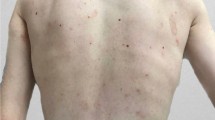Abstract
We report the case of a 14-year-old boy with a completely normal medical and social background (good student and handball practice). A dentist monthly followed this patient for an orthodontic treatment. Facing with symptoms associating purpura, pancytopenia, and limbs pain, the first diagnosis that came to mind to emergency pediatricians was acute leukemia and the patient was addressed to a hematology department. However, additional psychiatry investigations revealed an avoiding restrictive food intake disorder (ARFID) associated with serious vitamin deficiencies (Vitamins B9 and D) and responsible for scurvy, mimicking acute leukemia onset. Strikingly, this young patient has been undergoing a close medical follow-up since infancy because of a selective diet. Since growth, education, and development were normal, the risk of pursuing this unbalanced diet has been neglected and this child was admitted at diagnosis in a life-threatening condition.

Similar content being viewed by others
References
Padayatty SJ, Levine M. New insights into the physiology and pharmacology of vitamin C. CMAJ. 2001;164:353–5.
Ceglie G, Macchiarulo G, Marchili MR, Marchesi A, Rotondi Aufiero L, Di Camillo C, et al. Scurvy: still a threat in the well-fed first world? Arch Dis Child. 2018;104:381–3. https://doi.org/10.1136/archdischild-2018-315496.
Agarwal A, Shaharyar A, Kumar A, Bath MS, Mishra M. Scurvy in pediatric age group—a disease often forgotten? J Clin Orthop Trauma. 2015;6:101–07. https://doi.org/10.1016/j.jcot.2014.12.003.
Fisberg M, Brambilla A, Pizza C, Lachina L, Resti M, Trapani S. Pediatric scurvy: when contemporary eating habits bring back the past. Front Pediatr. 2018;6:126. https://doi.org/10.3389/fped.2018.00126.
Valentini D, Barbuti D, Grandin A, De Horatio LT, Villani A. A good growth in a child with scurvy. BMJ Case Rep. 2011. pii: bcr1020103383. https://doi.org/10.1136/bcr.10.2010.3383.
Author information
Authors and Affiliations
Corresponding author
Ethics declarations
Conflict of interest
The authors declare that they have no conflict of interest.
Additional information
Publisher’s note Springer Nature remains neutral with regard to jurisdictional claims in published maps and institutional affiliations.
Rights and permissions
About this article
Cite this article
Benezech, S., Hartmann, C., Morfin, D. et al. Is it leukemia, doctor? No, it’s scurvy induced by an ARFID!. Eur J Clin Nutr 74, 1247–1249 (2020). https://doi.org/10.1038/s41430-020-0640-5
Received:
Revised:
Accepted:
Published:
Issue Date:
DOI: https://doi.org/10.1038/s41430-020-0640-5
- Springer Nature Limited
This article is cited by
-
Scurvy, abnormal MRI, and gelatinous bone marrow in an adolescent with avoidant restrictive food intake disorder
Journal of Eating Disorders (2023)
-
Vitamin D and hypophosphatemia in patients with anorexia nervosa and avoidant/restrictive food intake disorder: a case control study
Journal of Eating Disorders (2023)
-
How genetic analysis may contribute to the understanding of avoidant/restrictive food intake disorder (ARFID)
Journal of Eating Disorders (2022)
-
Non-Hodgkin lymphoma mimicking acute leukemia: a report of six cases and review of the literature
Journal of Hematopathology (2022)
-
Suspicion of Munchausen syndrome by proxy with a child's presentation of undernutrition, scurvy, and an apparent Avoidant Restrictive Food Intake Disorder
Eating and Weight Disorders - Studies on Anorexia, Bulimia and Obesity (2022)




